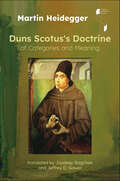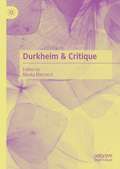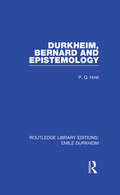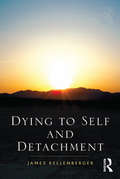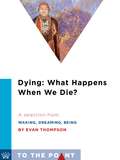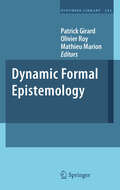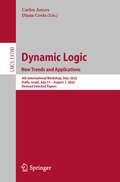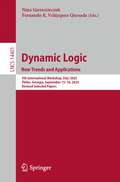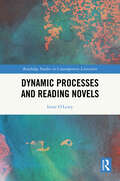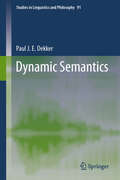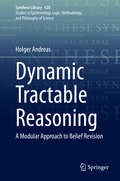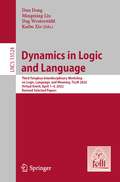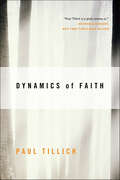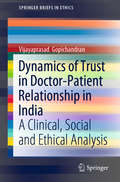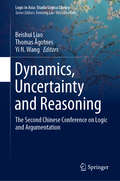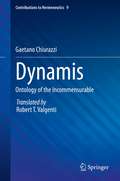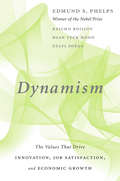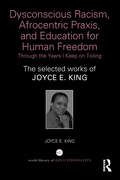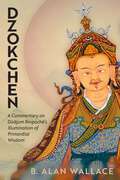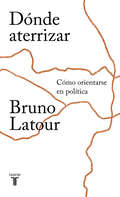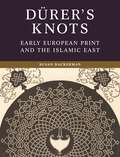- Table View
- List View
Duns Scotus's Doctrine of Categories and Meaning (Studies in Continental Thought)
by Martin HeideggerDuns Scotus's Doctrine of Categories and Meaning is a key text for the origins of Martin Heidegger's concept of "facticity." Originally submitted as a postdoctoral thesis in 1915, it focuses on the 13th-century philosopher-theologian John Duns Scotus. Heidegger first analyzes Scotus's doctrine of categories, then offers a meticulous explanation of the Grammatica Speculativa, a work of medieval grammar now known to be authored by the Modist grammarian Thomas of Erfurt. Taken together, these investigations represent an early foray into Heidegger's lifelong philosophical concerns, "the question of being in the guise of the problem of categories and the question of language in the guise of the doctrine of meaning."This new and unique translation of one of Heidegger's earliest works offers an important look at his early thinking before the question of being became his central concern and will appeal to readers exploring Heidegger's philosophical development, medieval philosophy, phenomenological interpretations of the history of philosophy, and the philosophy of language.
Durkheim & Critique
by Nicola MarcucciThis book investigates the relation between Durkheim’s sociology, Critical Theory, and the philosophy of social sciences. The book is organized in four sections: confronting Durkheim and other critical traditions; inquiring his social and critical ontology; interrogating the relation between social practices and justice; and discussing his relevance in contemporary politics and political theory. An international group of philosophers, sociologists, and critical theorists contribute to show Durkheim’s reflection as an important complement—or an alternative—to the Hegelian-Marxist and post-structuralist conceptions of social critique. In this way, the book intends to inaugurate a new reflection on social critique at the intersection between philosophy and sociological theory.
Durkheim, Bernard and Epistemology (Routledge Library Editions: Emile Durkheim)
by Paul Q. HirstThis title, first published in 1975, contains two complimentary studies by Paul Q. Hirst: the first based on Claude Bernard’s theory of scientific knowledge, and the second concerning Emile Durkheim’s attempt to provide a philosophical foundation for a scientific sociology in The Rules of Sociological Method. The author’s primary concern is to answer the question: is Durkheim’s theory of knowledge logically consistent and philosophically viable? His principal conclusion is that the epistemology developed in the Rules is an impossible one and that its inherent contradictions are proof that sociology as it is commonly understood can never be a scientific discipline.
Duties Regarding Nature: A Kantian Environmental Ethic (Routledge Studies in Ethics and Moral Theory)
by Toby SvobodaIn this book, Toby Svoboda develops and defends a Kantian environmental virtue ethic, challenging the widely-held view that Kant's moral philosophy has little to offer environmental ethics. On the contrary, Svoboda contends that on Kantian grounds, there is good moral reason to care about non-human organisms in their own right and to value their flourishing independently of human interests, since doing so is constitutive of certain (environmental) virtues. Svoboda argues that Kant’s account of indirect duties regarding nature can ground a compelling environmental ethic: the Kantian duty to develop morally virtuous dispositions strictly proscribes unnecessarily harming organisms, and it also gives us moral reason to act in ways that benefit such organisms. Svoboda’s account engages the recent literature on environmental virtue (including Rosalind Hursthouse, Philip Cafaro, Ronald Sandler, Thomas Hill, and Louke van Wensveen) and provides an original argument for an environmental ethic firmly rooted in Kant’s moral philosophy.
Duty and the Beast: Should We Eat Meat in the Name of Animal Rights?
by Andy LameyThe moral status of animals is a subject of controversy both within and beyond academic philosophy, especially regarding the question of whether and when it is ethical to eat meat. A commitment to animal rights and related notions of animal protection is often thought to entail a plant-based diet, but recent philosophical work challenges this view by arguing that, even if animals warrant a high degree of moral standing, we are permitted - or even obliged - to eat meat. Andy Lamey provides critical analysis of past and present dialogues surrounding animal rights, discussing topics including plant agriculture, animal cognition, and in vitro meat. He documents the trend toward a new kind of omnivorism that justifies meat-eating within a framework of animal protection, and evaluates for the first time which forms of this new omnivorism can be ethically justified, providing crucial guidance for philosophers as well as researchers in culture and agriculture.
Duverger's Law of Plurality Voting
by Shaun Bowler Bernard Grofman André BlaisMaurice Duverger is arguably the most distinguished French political scientist of the last century, but his major impact has, strangely enough, been largely in the English-speaking world. His book, Political Parties, first translated into English in 1954, has been very influential in both the party politics literature (which continues to make use of his typology of party organization) and in the electoral systems literature. His chief contributions there deal with what have come to be called in his honor Duverger's Law and Duverger's Hypothesis. The first argues that countries with plurality-based electoral methods will tend to become two-party systems; the second argues that countries using proportional representation (PR) methods will tend to become multi-party systems. Duverger also identifies specific mechanisms that will produce these effects, conventionally referred to as "mechanical effects", and "psychological effects". However, while Duverger's Hypothesis concerning the link between PR and multipartism is now widely accepted; the empirical evidence that plurality voting results in two-party systems is remarkably weak--with the U.S. the most notable exception. The chapters in this volume consider national-level evidence for the operation of Duverger's law in the world's largest, longest-lived and most successful democracies of Britain, Canada, India and the United States. One set of papers involves looking at the overall evidence for Duverger's Law in these countries; the other set deals with evidence for the mechanical and incentive effects predicted by Duverger. The result is an incisive analysis of electoral and party dynamics.
Dying to Self and Detachment
by James KellenbergerExploring the religious category of dying to self, this book aims to resolve contemporary issues that relate to detachment. Beginning with an examination of humility in its general notion and as a religious virtue that detachment presupposes, Kellenberger draws on a range of ancient, medieval, modern, and contemporary sources that address the main characteristics of detachment, including the work of Meister Eckhart, St. Teresa, and Simone Weil, as well as writers as varied as Gregory of Nyssa, Rabi'a al-Adawiyya, Søren Kierkegaard, Andrew Newberg, John Hick and Keiji Nishitani. Kellenberger explores the key issues that arise for detachment, including the place of the individual's will in detachment, the relationship of detachment to desire, to attachment to persons, and to self-love and self-respect, and issues of contemporary secular detachment such as inducement via chemicals. This book heeds the relevance of the religious virtue of detachment for those living in the twenty-first century.
Dying: Self and Consciousness in Neuroscience, Meditation, and Philosophy
by Evan ThompsonIn the ancient Indian epic, Mahabharata, the Lord of Death asks, "What is the most wondrous thing in the world?", and his son answers, "It is that all around us people can be dying and we don't believe it can happen to us." This refusal to face the inevitability of death is especially prevalent in modern Western societies. We look to science to tell us how things are but biomedicine and neuroscience divest death of any personal significance by presenting it as just the breakdown of the body and the cessation of consciousness. The Tibetan Buddhist perspective stands in sharp contrast to this modern scientific notion of death. This tradition conceives dying not as the mere termination of living processes within the body, but as a rite of passage and transformation of consciousness. Physical death, in this tradition, initiates a transition from one of the six bardos ("in-between states") of consciousness to an opportunity for total enlightenment. In Dying: What Happens When We Die?, Evan Thompson establishes a middle ground between the depersonalized, scientific account of death and the highly ritualized notion of death found in Tibetan Buddhism. Thompson's depiction of death and dying offers an insightful neurobiological analysis while also delving into the phenomenology of death, examining the psychological and spiritual effects of dying on human consciousness. In a trenchant critique of the near-death experience literature, he shows that these experiences do not provide evidence for the continuation of consciousness after death, but also that they must be understood phenomenologically and not in purely neuroscience terms. We must learn to tolerate the "ultimate ungraspability of death" by bearing witness to dying and death instead of turning away from them. We can learn to face the experience of dying through meditative practice, and to view the final moments of life not as a frightening inevitability to be shunned or ignored, but as a deeply personal experience to be accepted and even embraced..
Dynamic Formal Epistemology
by Olivier Roy Patrick Girard Mathieu MarionThis volume is a collation of original contributions from the key actors of a new trend in the contemporary theory of knowledge and belief, that we call "dynamic epistemology". It brings the works of these researchers under a single umbrella by highlighting the coherence of their current themes, and by establishing connections between topics that, up until now, have been investigated independently. It also illustrates how the new analytical toolbox unveils questions about the theory of knowledge, belief, preference, action, and rationality, in a number of central axes in dynamic epistemology: temporal, social, probabilistic and even deontic dynamics.
Dynamic Logic. New Trends and Applications: 4th International Workshop, DaLí 2022, Haifa, Israel, July 31–August 1, 2022, Revised Selected Papers (Lecture Notes in Computer Science #13780)
by Carlos Areces Diana CostaThis book constitutes revised selected papers from the refereed proceedings of the 4th International Workshop on Dynamic Logic, DaLí 2022, held in Haifa, Israel, in July/August 2022.The 8 full papers presented in this volume were carefully reviewed and selected from 22 submissions. They deal with new trends and applications in the area of Dynamic Logic.
Dynamic Logic. New Trends and Applications: 5th International Workshop, DaLí 2023, Tbilisi, Georgia, September 15–16, 2023, Revised Selected Papers (Lecture Notes in Computer Science #14401)
by Nina Gierasimczuk Fernando R. Velázquez-QuesadaThis book constitutes the revised selected papers of the 5th International Workshop on Dynamic Logic. New Trends and Applications, DaLí 2023, held in Tbilisi, Georgia, during September 15–16, 2023. The 8 full papers in this book were carefully reviewed and selected from 10 submissions. They deal with new trends and applications in the area of Dynamic Logic.
Dynamic Processes and Reading Novels (Routledge Studies in Contemporary Literature)
by Irene O’LearyThis book is about the dynamic processes that generate novel-reading. It takes the view that the world is composed of dynamic processes and introduces a process dynamics approach to articulate this stance. This fresh perspective draws on literary studies, process philosophy and neuroscience to argue that dynamic literary and microcognitive processes constantly reconfigure the conditions that they co-create during reading. Analyses of The PowerBook by Jeanette Winterson, The Curious Incident of the Dog in the Night-time by Mark Haddon and Oryx and Crake by Margaret Atwood consider style, narration, allusion and creativity in interaction with diverse microcognitive processes involved in reading. The analyses are strengthened by taking live action into account, illuminating changes that many critical perspectives miss or standardise and avoiding reliance on illusory ideal readers and readings. In proposing a process approach to dynamics and its analysis, this book paves the way for new research across disciplines.
Dynamic Semantics
by Paul J.E. DekkerThe integrated theory of dynamic interpretation set out here will be a surprise to advanced researchers in linguistics. It combines classical formal semantics and modern dynamic semantics without altering the fundamental paradigm. At the book's core lies a pragmatically motivated notion of a dynamic conjunction of meanings, an idea that is worked out in full formal detail. This is applied to linguistic phenomena that involve anaphora, quantification and modality. The author demonstrates that in each area of application existing data can be neatly combined with new dynamic insights, but more importantly, there is a genuine further pay-off: the work generates treatments of phenomena that were not initially intended, with functional readings of pronouns and quantifiers, 'Hob-Nob' sentences, and insights into what we now call 'Pierce's Puzzle'. The outcome of a decade of work by the Amsterdam School of dynamic semantics, this volume condenses and reflects upon a vital body of research.
Dynamic Tractable Reasoning: A Modular Approach to Belief Revision (Synthese Library #420)
by Holger AndreasThis book aims to lay bare the logical foundations of tractable reasoning. It draws on Marvin Minsky's seminal work on frames, which has been highly influential in computer science and, to a lesser extent, in cognitive science. Only very few people have explored ideas about frames in logic, which is why the investigation in this book breaks new ground. The apparent intractability of dynamic, inferential reasoning is an unsolved problem in both cognitive science and logic-oriented artificial intelligence. By means of a logical investigation of frames and frame concepts, Andreas devises a novel logic of tractable reasoning, called frame logic. Moreover, he devises a novel belief revision scheme, which is tractable for frame logic. These tractability results shed new light on our logical and cognitive means to carry out dynamic, inferential reasoning. Modularity remains central for tractability, and so the author sets forth a logical variant of the massive modularity hypothesis in cognitive science.This book conducts a sustained and detailed examination of the structure of tractable and intelligible reasoning in cognitive science and artificial intelligence. Working from the perspective of formal epistemology and cognitive science, Andreas uses structuralist notions from Bourbaki and Sneed to provide new foundational analyses of frames, object-oriented programming, belief revision, and truth maintenance. Andreas then builds on these analyses to construct a novel logic of tractable reasoning he calls frame logic, together with a novel belief revision scheme that is tractable for frame logic. Put together, these logical analyses and tractability results provide new understandings of dynamic and inferential reasoning.Jon Doyle, North Carolina State University
Dynamical Models In Neurocognitive Psychology
by Ralf EngbertThe development of cognitive models is a key step in the challenging research program to advance our understanding of human cognition and behavior. Dynamical models represent a general and flexible approach to cognitive modeling. This introduction focuses on applications of stochastic processes and dynamical systems to model cognition. The dynamical approach is particularly useful to emphasize the strong link between experimental research (and its paradigms), data analysis, and mathematical models including their computer implementation for numerical simulation. Most of specific examples are from the domain of eye movement research, with concepts being applicable to a broad range of problems in cognitive modeling. The textbook aims at the graduate and/or advanced undergraduate level for students in Cognitive Science and related disciplines such as Psychology and Computer Science. Joint introduction of the theory of cognitive processes and mathematical models, their underlying mathematical concepts, numerical simulation, and analysis;The focus on eye movements provide a theoretically coherent, but very general application area;Computer code in R Programming Language for Statistical Computing is available for all examples, figures, and solutions to exercises.
Dynamics in Logic and Language: Third Tsinghua Interdisciplinary Workshop on Logic, Language, and Meaning, TLLM 2022, Virtual Event, April 1–4, 2022, Revised Selected Papers (Lecture Notes in Computer Science #13524)
by Mingming Liu Dun Deng Dag Westerståhl Kaibo XieEdited in collaboration with FoLLI, the Association of Logic, Language and Information, this book constitutes the refereed proceedings of the Third Tsinghua Interdisciplinary Workshop on Logic, Language, and Meaning, TLLM 2022, which was held virtually in April 2022.The 9 full papers presented in this volume were carefully reviewed and selected from 13 submissions. The workshop covers a wide range of topics such as dynamic semantics, logical dynamics, Dynamic Epistemic Logic, Discourse Representation Theory, formal semantics, free choice inference, update semantics, and donkey sentences.
Dynamics of Faith
by Paul Tillich“A little classic,” this volume from the twentieth century Christian existentialist philosopher “reveals the astounding virtuosity of the man and the thinker” (Reinhold Niebuhr, New York Times Book Review).One of the greatest books ever written on the subject, Dynamics of Faith is a primer in the philosophy of religion. Paul Tillich, a leading theologian of the twentieth century, explores the idea of faith in all its dimensions, while defining the concept in the process.This graceful and accessible volume contains a new introduction by Marion Pauck, Tillich's biographer.“A good introduction for those who would like to get acquainted with [Tillich], an important clarification of his thought for those who have struggled through his earlier books and an important essay in its own right.” —Albert C. Outler“Eagerly welcomed by all serious students of man and religion.” —Publishers Weekly, starred review“The best introduction to Tillich . . . a lucid exposition of the doctrine of faith as ‘ultimate concern.’” –New York Times
Dynamics of Trust in Doctor-Patient Relationship in India: A Clinical, Social and Ethical Analysis (SpringerBriefs in Ethics)
by Vijayaprasad GopichandranThis book offers an easy-to-read, yet comprehensive introduction to practical issues in doctor–patient relationships in a typical low- and middle-income country setting in India, examining in detail the reasons for erosion of trust and providing guidance on potential research areas in the field. It strikes a balance between empirical work and theoretical normative analysis, while adopting mixed-method research in exploring important constructs in the doctor–patient relationship, such as trust, solidarity, advocacy, patient-centeredness, privacy, and confidentiality. Since the concept of trust has direct implications for the ethical practice of medicine, the book is a valuable resource for academics and researchers in the field of medical, clinical, and applied ethics.
Dynamics, Uncertainty and Reasoning: The Second Chinese Conference on Logic and Argumentation (Logic in Asia: Studia Logica Library)
by Beishui Liao Thomas Ågotnes Yi N. WangThis volume collects selected papers presented at the Second Chinese Conference on Logic and Argumentation in 2018 held in Hangzhou, China. The papers presented reflect recent advances in logic and argumentation, as well as the connections between the two, and also include invited papers contributed by leading experts in these fields. The book covers a wide variety of topics related to dynamics, uncertainty and reasoning. It continues discussions on the interplay between logic and argumentation which has a long history from Aristotle’s ancient logic to very recent formal argumentation in AI.
Dynamis: Ontology of the Incommensurable (Contributions to Hermeneutics #9)
by Gaetano ChiurazziThis book offers a new and original hypothesis on the origin of modal ontology, whose roots can be traced back to the mathematical debate about incommensurable magnitudes, which forms the implicit background for Plato’s later dialogues and culminates in the definition of being as dynamis in the Sophist. Incommensurable magnitudes – also called dynameis by Theaetetus – are presented as the solution to the problem of non-being and serve as the cornerstone for a philosophy of difference and becoming. This shift also marks the passage to another form of rationality – one not of the measure, but of the mediation. The book argues that the ontology and the rationality which arise out of the discovery of incommensurable constitutes a thread that runs through the entire history of philosophy, one that leads to Kantian transcendentalism and to the philosophies derived from it, such as Hegelianism and philosophical hermeneutics.Readers discover an insightful exchange with some of the most important issues in philosophy, newly reconsidered from the point of view of an ontology of the incommensurable. These issues include the infinite, the continuum, existence, and difference. This text appeals to students and researchers in the fields of ancient philosophy, German idealism, philosophical hermeneutics and the history of mathematics.
Dynamism: The Values That Drive Innovation, Job Satisfaction, and Economic Growth
by Edmund S. Phelps Gylfi Zoega Raicho Bojilov Hian Teck HoonNobel Laureate Edmund Phelps and an international group of economists argue that economic health depends on the widespread presence of certain values, in particular individualism and self-expression. Nobel Laureate Edmund Phelps has long argued that the high level of innovation in the lead nations of the West was never a result of scientific discoveries plus entrepreneurship, as Schumpeter thought. Rather, modern values—particularly the individualism, vitalism, and self-expression prevailing among the people—fueled the dynamism needed for widespread, indigenous innovation. Yet finding links between nations’ values and their dynamism was a daunting task. Now, in Dynamism, Phelps and a trio of coauthors take it on. Phelps, Raicho Bojilov, Hian Teck Hoon, and Gylfi Zoega find evidence that differences in nations’ values matter—and quite a lot. It is no accident that the most innovative countries in the West were rich in values fueling dynamism. Nor is it an accident that economic dynamism in the United States, Britain, and France has suffered as state-centered and communitarian values have moved to the fore. The authors lay out their argument in three parts. In the first two, they extract from productivity data time series on indigenous innovation, then test the thesis on the link between values and innovation to find which values are positively and which are negatively linked. In the third part, they consider the effects of robots on innovation and wages, arguing that, even though many workers may be replaced rather than helped by robots, the long-term effects may be better than we have feared. Itself a significant display of creativity and innovation, Dynamism will stand as a key statement of the cultural preconditions for a healthy society and rewarding work.
Dysconscious Racism, Afrocentric Praxis, and Education for Human Freedom: The selected works of Joyce E. King
by Joyce E. KingA dynamic leader and visionary teacher/scholar, Joyce E. King has made important contributions to the knowledge base on preparing teachers for diversity, culturally connected teaching and learning, and inclusive transformative leadership for change, often in creative partnership with communities. Dr. King is internationally recognized for her innovative interdisciplinary scholarship, teaching practice, and leadership. Her concept of "dysconscious racism" continues to influence research and practice in education and sociology in the U.S. and in other countries. This volume weaves together ten of her most influential writings and four invited reflections from prominent scholars on the major themes the work addresses. In the World Library of Educationalists, international scholars themselves compile career-long collections of what they judge to be their finest pieces—extracts from books, key articles, salient research findings, major theoretical and/or practical contributions—so the world can read them in a single manageable volume. Readers will be able to follow the themes and strands of their work and see their contribution to the development of a field.
Dzokchen: A Commentary on Dudjom Rinpoché's "Illumination of Primordial Wisdom"
by B. Alan WallacePith Instructions for Realizing the Great Perfection, from One of the Greatest Tibetan Yogis of the Twentieth Century.In the concise yet comprehensive practice manual entitled The Illumination of Primordial Consciousness, the great twentieth-century Tibetan Nyingma master Dudjom Rinpoche lays out a sequential path to spiritual freedom according to the teachings of the Great Perfection (Dzokchen): First, we refine our awareness by training in meditative quiescence (shamatha) and then proceed to the cultivation of contemplative insight (vipashyana), by which our mind&’s basic nature of luminosity and emptiness is revealed. Then, having recognized that the ordinary, deluded mind is actually without any intrinsic essence, we are primed to cut through this conditioned mind into unborn, timeless pristine awareness, which has never been contaminated by mental afflictions or other obscurations. Finally, we realize that our own awareness has never been other than the dharmakaya, the mind of a buddha, and perfect enlightenment is realized spontaneously and effortlessly. In this book, beloved teacher and renowned scholar Lama B. Alan Wallace shares insights gained over years of study, providing a line-by-line explanation interspersed with background teachings from revered Dzokchen scriptures written by Padmasambhava, Dudjom Lingpa, and others. Also included are a set of fifteen guided meditations given by Lama Alan, along with links to audio tracks of Lama Alan giving the instructions himself. Through the practices he describes, the mystery of the mind—its origin and what happens to it at death–is thus illuminated through one&’s own meditative experience.
Dónde aterrizar
by Bruno LatourBruno Latour, uno de los pensadores más influyentes del mundo, traza un plan de supervivencia con un nuevo actor: la propia Tierra. El panorama político de los últimos cincuenta años se caracteriza por un peligroso cóctel compuesto de tres ingredientes: la explosión vertiginosa de las desigualdades, la masiva desregulación y la sistemática maniobra de negación del cambio climático. Dónde aterrizar relaciona estos tres fenómenos de sobra conocidos pero cuyos puntos en común han pasado en gran medida desapercibidos. Por ello, la gran energía política que se podría extraer de esta conexión tampoco ha sido aún aprovechada. Lo que subyace a estas tendencias es la convicción, compartida por los poderosos, de que la amenaza ecológica es real y que la única forma de sobrevivir es abandonar la idea de un futuro común. De ahí su potente inversión en la negación del cambio climático. La tesis de Latour es que no se puede entender ese panorama político si no otorgamos un papel central a la mutación ecológica. Para autor, las clases dirigentes han llegado a la conclusión de que no queda espacio en la tierra para ellas ni para el resto de la gente. En un momento en el que aumenta la insatisfacción con el ideal de la modernidad, se refuerzan las fronteras nacionales o incluso étnicas y el sueño de la globalización se ha convertido en una pesadilla para la mayoría de las personas, es urgente que aterricemos. Latour traza un mapa de los puntos de vista impuestos por este nuevo panorama y redefine lo que realmente está en juego, mucho más allá de la discusión sobre la izquierda y la derecha o lo global y lo nacional: cómo habitar la Tierra es nuestro mayor desafío. La crítica ha dicho...«Fascinante. Latour es uno de los pensadores más interesantes de la escena intelectual mundial. Sabe cómo llamar nuestra atención sobre la complejidad de los problemas, manteniendo una claridad expositiva fuera de lo común.»La Stampa «La elección de Donald Trump ha sacado de sus casillas a Bruno Latour. Y cuando este imperturbable filósofo y antropólogo, de temperamento alegre, se sale de sus casillas, se dirige al poder maligno en un estilo deliberadamente abrupto, pero también elabora los medios para combatirlo. Una interesante invitación a recuperar el norte.»Philosophie Magazine «Una reflexión estimulante.»Les Inrockuptibles «Un acusación punzante, un "Yo acuso" a la escala de la biosfera.»Le Nouvel Observateur «Un panfleto afilado como un cristal, un manual del siglo venidero. Bruno Latour arroja luz sobre una situación que parece caótica pero en realidad es extremadamente coherente.»Libération «Una obra a la vez importante, sorprendente e inquietante.»Joseph Confavreux, Médiapart
Dürer’s Knots: Early European Print and the Islamic East
by Susan DackermanAn important new examination of Islamic themes in the art of Albrecht DürerAlbrecht Dürer&’s depictions of Muslim figures and subjects are considered by many to be among his most perplexing images. This confusion arises from the assumption that the artist and his northern European contemporaries regarded the Muslim Levant as an exotic faraway land inhabited by hostile adversaries, not a region of neighboring empires affiliated through political and mercantile networks. Susan Dackerman casts Dürer&’s art in an entirely new light, focusing on prints that portray cooperation between the Muslim and Christian worlds rather than conflict and war, enabling us to better understand early modern Europe through its visual culture.In this beautifully illustrated book, Dackerman provides new readings of three of the artist&’s most enigmatic print projects—Sea Monster, Knots, and Landscape with Cannon—situating them within historical contexts that reflect productive collaborations between Christendom and Islam, from the artistic and commercial to the ideological and political. Dackerman notes how Gutenberg&’s development of printing shares an inextricable relationship to the 1453 Ottoman siege of Constantinople. While Gutenberg&’s workshop produced a call to crusade and other publications antagonistic to the Muslim East, Dürer&’s prints, she shows, instead emphasize instances of affiliation between Christendom and Islam.A breathtaking work of scholarship, Dürer&’s Knots shows how the artist&’s prints of Muslim subjects give expression to the interconnectedness of Christian Europe and the Islamic East.
